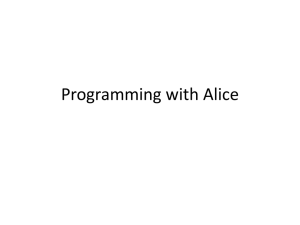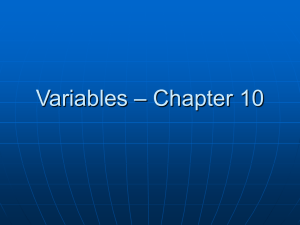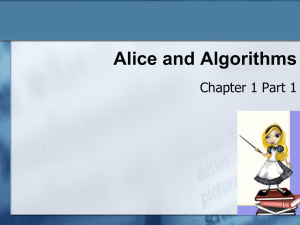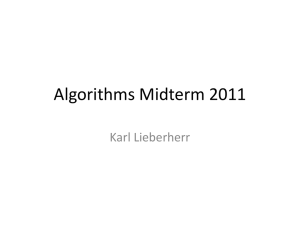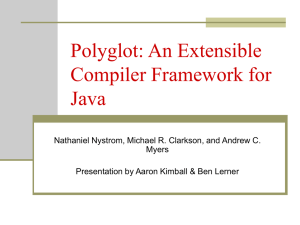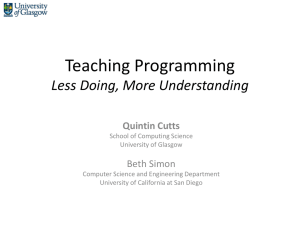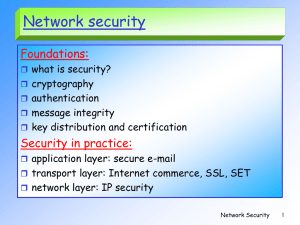PPT - CCSS - University of Southern California
advertisement
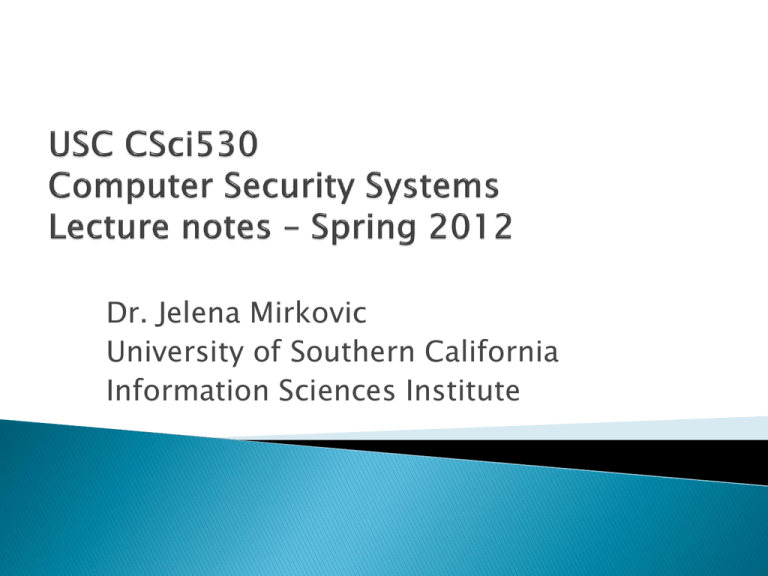
Dr. Jelena Mirkovic University of Southern California Information Sciences Institute If you wish to enroll and do not have D clearance yet, send an email to CSci530@usc.edu with: oYour name oWhich prerequisites you have completed oA phone number oRequest to receive a D clearance I will let you know within a day or two http://ccss.usc.edu/530 oSyllabus oAssignments oNews oLecture notes (also on DEN) Keep checking it! http://ccss.usc.edu/530L o1 of the 4 units oInstructor is David Morgan oInstruction 4 – 4:50 Fridays in RTH105 WebCast via DEN Hands on work in the lab – exercising the theoretical knowledge from class Some labs will be done remotely using DETER testbed Four reports, due as noted online Each discusses a paper of your choice from a few top security conferences/journals oSummary of the paper and its critique oYour ideas on the topic o2-4 pages, submitted via DEN oYou can submit reports early if you like One report from each student will be chosen for presentation in class Total 20% of your grade, 4% each 4 quizzes oDone before each DETER exercise oRepeated after the exercise oYou MUST take each quiz Total 5% of your grade Class e-mail: csci530@usc.edu (TA and inst) Instructor oDr. Jelena Mirkovic oOffice hours Fri 12:30-1:30pm or by appt in SAL 234 oContact via email (on class web page) TA oMelina Demertzi oOffice hours Tu and We 10-11 am oContact via email (on class web page) Grading: oPaper reports/presentations: 20% oLab: 20% oQuizzes: 5% oParticipation: 5% oMidterm Exam: 20% oFinal Exam: 30% Grades assigned using an absolute curve: A A- B+ B B- C+ C C- D+ D D 93 90 86 83 80 76 73 70 66 63 60 DEN system will host the class discussion board oTo gain access and log in https://mapp.usc.edu/ oContact webclass@usc.edu if you have difficulty with the system oI will check the discussion board once daily but if you want a reliable response from me email me directly Class participation is important oAsk and answer questions in class oAsk, answer, participate on-line Class participation carries 5% of your grade oIf I don’t remember you from class, I look in the web discussion forum to check participation Did you ask good questions Did you provide good answers Did you make good points in discussions oFor DEN students, discussion board is the primary means of class participation You can also call into the class if you like What is and is not OK oI encourage you to work with others to learn the material but everyone must DO their work ALONE oDo not to turn in the work of others oDo not give others your work to use as their own oDo not plagiarize from others (published or not) oDo not try to deceive the instructors See the Web site oMore guidelines on academic integrity oLinks to university resources oDon’t just assume you know what is acceptable. No o o o o o o o o o one should be able to: Break into my house Attack me Steal my TV Use my house to throw water balloons on people Damage my furniture Pretend to be my friend Bob and fool me Waste my time with irrelevant things Prevent me from going to my favorite restaurant Destroy my road, bridge, city .. No o o o o o o o I o o one should be able to: Break into my computer Attack my computer Steal my information Use my computer to attack others Damage my computer or data Use my resources without my permission Mess with my physical world want to talk to Alice Pretend to be Alice or myself or our computers Prevent me from communicating with Alice An o isolated computer has a security risk? Computer security aims to protect a single, connected, machine Networking = communication at all times and in all scenarios!!! o Network security aims to protect the communication and all its participants Computer security Security Network security = robustness or fault tolerance? Breaking o into my computer Hackers Break a password or sniff it off the network Exploit a vulnerability A vulnerability is a bug in the software that creates unexpected computer behavior when exploited, such as enabling access without login, running unauthorized code or crashing the computer. An exploit is an input to the buggy program that makes use of the existing vulnerability. Use social engineering Impersonate someone I trust Viruses and worms o Attacking o my computer Denial-of-service attacks A DOS attack aims to disrupt a service by either exploiting a vulnerability or by sending a lot of bogus messages to a computer offering a service o Viruses and some worms A virus is a self-replicating program that requires user action to activate such as clicking on E-mail, downloading an infected file or inserting an infected floppy, CD, etc .. A worm is a self-replicating program that does not require user action to activate. It propagates itself over the network, infects any vulnerable machine it finds and then spreads from it further. Stealing o o o my information From my computer or from communication I will use cryptography! There are many ways to break ciphers There are many ways to divulge partial information (e.g. who do you talk to) I would also like to hide who I talk to and when I will use anonymization techniques Anonymization hinders other security approaches that build models of normal traffic patterns Using o o o o my machine to attack others E-mail viruses Worms Denial-of-service attacks (including reflector attacks) Spam, phishing Damaging o o o o my computer or data I have to prevent break-ins I will also use cryptography to detect tampering I must replicate data to recover from tampering Denial-of-service attacks and worms can sometimes damage computers Taking up my resources with irrelevant messages o o o o Denial-of-service attacks Spam mail (takes time to read and fills space) Malicious mail (may contain a virus) Viruses and worms Messing o up with my physical world Cyber-physical attacks or collateral victims o o o o Power systems, traffic control, utilities Travel agencies Medical devices Smart vehicles Pretending computers o o o to be Alice or myself or our I want to be sure who I am talking to (authentication and digital signatures) It is hard to impersonate a computer in twoway communication, such as TCP But it has been done Plain IP spoofing seems an extremely hard problem to solve IP spoofing means putting a fake IP address in the sender field of IP packets. Preventing Alice o o o me from communicating with Alice could be attacked Routers could be overloaded or tampered with DNS servers could be attacked Confidentiality (C) oKeep data secret from non-participants Integrity (I) oAka “authenticity” oKeep data from being modified oKeep it functioning properly Availability (A) o Keep the system running and reachable No one should be able to: oBreak into my computer – A, C, I oAttack my computer – A, C, I oSteal my information - C oUse my computer to attack others – I? oDamage my computer or data - I o o I o o Use my resources without my permission – A Mess with my physical world – I, A want to talk to Alice Pretend to be Alice or myself or our computers – C, I Prevent me from communicating with Alice - A Policy oDeciding what confidentiality, integrity and availability mean Mechanism oImplementing the policy Your security frequently depends on others oTragedy of commons A good solution must o Handle the problem to a great extent o Handle future variations of the problem, too o Be inexpensive o Have economic incentive o Require a few deployment points o Require non-specific deployment points Fighting o o o o a live enemy Security is an adversarial field No problem is likely to be completely solved New advances lead to improvement of attack techniques Researchers must play a double game Attack patterns change Often there is scarce attack data Testing security systems requires reproducing or simulating legitimate and traffic o No agreement about realistic traffic patterns No agreement about metrics There is no standardized evaluation procedure Some security problems require a lot of resources to be reproduced realistically Risk analysis and risk management o How important it is to enforce a policy o Which threats matter o Legislation may play a role The role of trust o Assumptions are necessary Human factors o The weakest link Motivation o Bragging Rights o Profit (Spam, Scam, Phishing, Extortion) o Revenge / to inflict damage o Terrorism, politics Risk to the attacker o Usually small o Can play a defensive role Buggy code Protocol design failures Weak crypto Social engineering/human factor Insider threats Poor configuration Incorrect policy specification Stolen keys or identities Misplaced incentives (DoS, spoofing, tragedy of commons) Policy defines what is allowed and how the system and security mechanisms should act Policy is enforced by mechanism which interprets and enforces it, e.g. o Firewalls o IDS o Access control lists Implemented as o Software (which must be implemented correctly and without vulnerabilities) Encryption Checksums Key management Authentication Authorization Accounting Firewalls VPNs Intrusion Detection Intrusion Response Virus scanners Policy managers Trusted hw Most deployment of security services today handles the easy stuff, implementing security at a single point in the network, or at a single layer in the protocol stack: o Firewalls, VPN’s o IPSec o SSL o Virus scanners o Intrusion detection Unfortunately, security isn’t that easy. It must be better integrated with the application. o At the level at which it must ultimately be specified, security policies pertain to application level objects, and identify application level entities (users). Security is made even more difficult to implement since today’s systems lack a central point of control. o Home machines unmanaged o Networks managed by different organizations. o A single function touches machines managed by different parties. Clouds o Who is in control? Goal: Protect private communication in the public world Alice and Bob are shouting messages in a crowded room Everyone can hear what they are saying but no one can understand (except them) We have to scramble the messages so they look like nonsense or alternatively like innocent text Only Alice and Bob know how to get the real messages out of the scramble Authentication o Bob should be able to verify that Alice has created the message Integrity o checking Bob should be able to verify that message has not been modified Non-repudiation o Alice cannot deny that she indeed sent the message Exchanging a secret with someone you have never met, shouting in a room full of people Proving to someone you know some secret without giving it away Sending secret messages to any m out of n people so only those m can retrieve messages and the rest n-m cannot Sending a secret message so that it can be retrieved only if m out of n people agree to retrieve it Alice could give a message covertly “Meeting at the old place” o Doesn’t work for arbitrary messages and o Doesn’t work if Alice and Bob don’t know each other Alice could hide her message in some other text – steganography Alice could change the message in a secret way o Bob has to learn a new algorithm o Secret algorithms can be broken by bad guys Good cryptography assumes knowledge of algorithm by anyone, secret lies in a key!!! Substitute each letter with a letter which is 3 letters later in the alphabet o HELLO becomes KHOOR Instead of using number 3 we could use n [1,25]. n would be our key How can we break this cipher? Can you decipher this: Bpqa kzgxbwozixpg ammua zmit miag. Em eivb uwzm! We can also choose a mapping for each letter: (H is A, E is M, L is K, O is Y). This mapping would be our key. This is monoalphabetic cipher. o HELLO becomes AMKKY How can we break this cipher? Symmetric key crypto: one key o We will call this secret key or shared key o Both Alice and Bob know the same key Asymmetric key crypto: two keys o Alice has public key and private key o Everyone knows Alice’s public key but only Alice knows her private key o One can encrypt with public key and decrypt with private key or vice versa Hash functions: no key o Output depends on input in non-linear fashion
